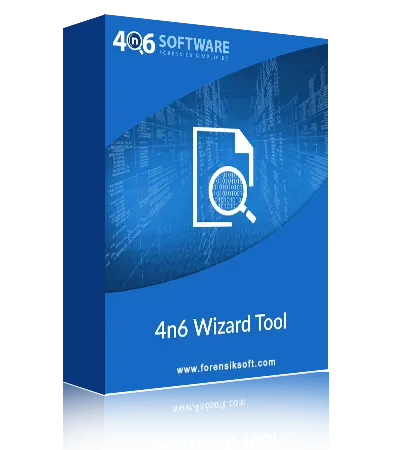Multi-Format Database File Analysis
The 4n6 Database Forensics Software is built to support all database files and these can range from current applications to legacy systems - Giving forensic investigators flexibility in both cases and approaches to different sources of data. This flexibility gives forensic investigators comfort by allowing them to extract, view and analyze data across multiple types of sources with the one solution!
Supported database file types include:
- DBF files (used by dBase, FoxPro)
- SQLite / LiteDB files (.db format used in browsers, mobile apps, and embedded systems)
- Microsoft Access files (.accdb format used in business and desktop applications)
- Paradox database files, still found in legacy software environments
After selecting a file from Open > Choose File Type > Browse, the Database forensics tool automatically analyzes the file's internal structure and displays all tables and data content in a readable format.

Live Database Server Connectivity
The Database Forensics Tool can do even more than static files; you can connect directly to live databases instantiated on all three of the most popular server platforms. This is key when working in enterprise environments in which users might have their data on active production or test systems.
The tool provides direct connection capabilities to:
- MySQL
- PostgreSQL
- Oracle
- Microsoft SQL Server
The DB investigation tool requires only three details from users to establish a connection:
- Server Name or IP
- Port Number
- Username and Password
- Service Name (in the case of Oracle)
The Database Forensics Software establishes a connection with the server to automatically pull every schema and table together with their records directly from the server. Live server-side forensic analysis becomes possible through this method.

Structured Table View with Auto Indexing
When a user loads a database file or connects to a server, they receive a complete table view or a table view showing a smaller subset of data in a structured manner. These views are arranged in a spreadsheet-like design providing a clear view of the rows and columns and the data types..
Key highlights include:
- Auto-calculated table and row counts.
- Clear column-wise data with headers, field types, and values.
- Direct visibility into large datasets without running SQL queries.
This organized interface of Database Forensics Tool allows for more thorough investigations without needing technical knowledge of the database system itself.

Powerful Search and Filtering Options
The built-in search capabilities of Database forensics software allows investigators to efficiently search for pertinent records or tables without doing a lot of manual scrolling through sizable datasets.
Capabilities include:
- Table Name Search: Users can locate particular tables through complete or partial name searches.
- Record Keyword Search: Enables users to locate table rows that contain specific keywords or identifiers.
- Real-Time Filtering: Instantly filter visible results through real-time functionality without having to reload data.
These functions are especially useful for researchers who have time sensitive cases with thousands of records across a number of tables.

Error and Warning Detection System
The Database Forensics Tool offers dedicated interfaces that automatically detect database issues while generating automatic reports. The 4n6 DB forensics software improves your forensic assessment standards by implementing this function.
Capabilities include:
- Error Tab: Shows corrupt, unreadable or unsupported data structures.
- Warning Tab: Shows missing records, deprecated fields or erratic behavior in the database schema.
This built-in logging system allows investigators to quickly focus their attention on suspicious or tampered datasets.

Customizable Export to CSV
With Database Forensics Tool users have the option to export either individual tables or complete database contents into CSV format to generate reports as well as produce court documentation and additional database investigation & analysis after selecting needed evidence.
Export options include:
- Selecting one or more tables to export.
- Setting a custom destination path.
- Automatically deleting older folders before a new export.
- Opening the export location after completion.
The exported CSV files keep their structure and work with eDiscovery platforms, Excel, and other forensic tools.

Session Management and Case Organization
To make the database investigations more efficient, the Database Forensics Tool has functionality to manage ongoing and previous investigations.
- Recent Files: Users can easily access and reload databases that they have previously analyzed.
- Clear File/Folder options: Allows users to clear currently loaded files to allow starting fresh without leaving the tool.
By using these controls, analysts can effectively manage case data, and minimize confusion in multi-case processing.
Flexible File Selection Modes
No matter if you're working with just one Database Forensics Tool can be used in two modes of selection, for you to choose from.
- Select Files: Select manually one or more database files.
- Pick and Folders: Load folders full of supported files in one go.
This function and easy-to-use workflow of 4n6 dBInvestigator brings convenience in the case acquisition and maximizes the entire case process at the same time.

Compatibility with Forensic Workflows
While the 4n6 Database Forensics Tool is operational as an independent solution, it is designed to work with other products seamlessly. Compatibility extends to the convenience with which the 4n6 database forensics software exports CSV files, which can be imported into:
- Excel for more sophisticated analysis, investigation, reporting, and visualization.
- eDiscovery systems for efficient case handling.
- Other forensic software for analysis involving disks, mobile, or network evidence.
Such compatibility makes the tool complementary in enterprise forensic systems and multi-disciplinary forensic investigations.

Timestamps and Audit Trail Validation
In a database record, you may see metadata such as time-stamps which is essential for creating timelines, verifying user activity. This database forensics tool helps investigators look at the time-stamp details for each record, enabling them to:
The feature supports:
- Preservation of original evidence.
- Maintenance of chain of custody.
- Being admissible in legal and regulatory proceedings.
The 4n6 Database Forensics Software was built and designed for forensic integrity and safe handling of sensitive digital evidence.

Read-Only Architecture for Data Integrity
All operations carried out by the 4n6 Database forensics tool are done in read-only mode so as to keep the source database, either file-based or server-hosted, unchanged during analysis.
- Confirm when the evidence was created and last modified.
- Detect changes made without authorization or knowledge outside established policy.
- Relate events in different systems where there is time-based evidence.
For fraud investigations, internal security review processes, and regulatory compliance cases, this knowledge is essential and invaluable.

Built-in Parsing and No External Dependencies
The Database Investigation Tool has an autonomous parsing engine that can load and interpret several types of database files without needing any outside software, database clients, or drivers. This is particularly useful for:
- Forensic laboratories with restricted access.
- Investigations conducted from offline or remote locations.
- Situations with restricted installations of software from outside sources.
The Database Investigate Software functions effortlessly in restricted environments, aiding in the preservation of security and autonomy.

Behavioral Analysis and Event Reconstruction
The Database Forensics Tool provides all the information, including log entries, modifications, and time-based markers which are important for manual event reconstruction. Investigators can analyze the data for trends, monitor the creation and deletion of records, and track changes within a database. This information is critical to developing a full narrative for legal, forensic, or compliance reporting.
Recovery of Deleted Records
The 4n6 Database Forensics tool can recover records that may have been intentionally or unintentionally removed, allowing access to data that would otherwise be hidden or inaccessible. The Database Forensics Software can recover table entries, and data fragments where possible, allowing investigators to recover incomplete tables, or potentially analyze deleted artifacts, that might inform an investigation.
![]() (Average Rating 4.8 Based on 102 Reviews)
(Average Rating 4.8 Based on 102 Reviews) 









